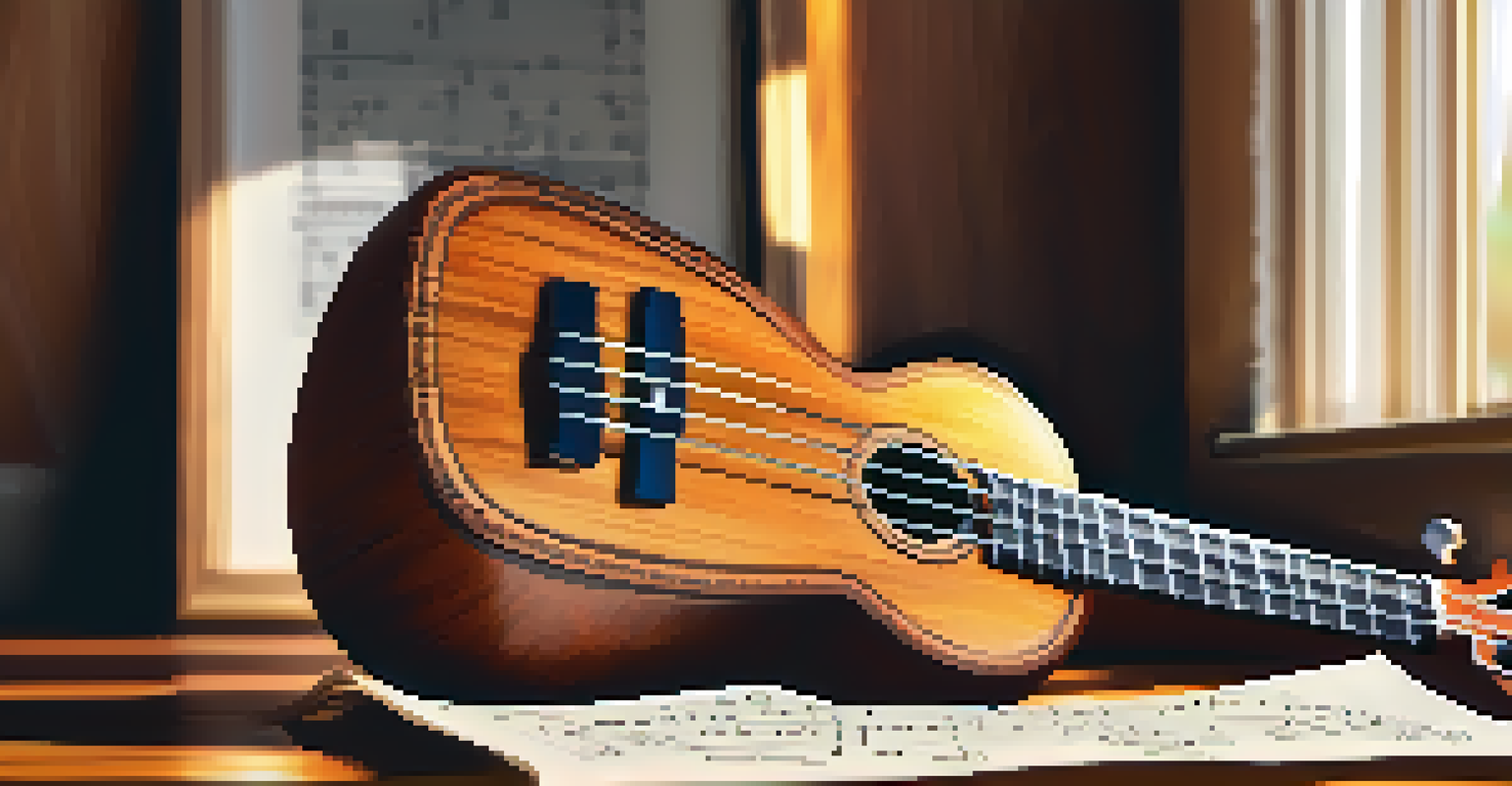How to Identify Chords When Transcribing Songs for Ukulele

Understanding the Basics of Chords in Music
Before diving into transcribing songs, it's crucial to grasp what chords are. Chords are simply a combination of notes played together, creating harmony. For ukulele players, these typically consist of a root note and a few other notes that complement it, making it a delightful harmony to strum along with.
Music is the shorthand of emotion.
When you hear a song, identifying the chords can give you a roadmap to play it. Each chord has a distinct sound or 'color,' which can help you recognize it. Understanding major and minor chords, for instance, is fundamental since they evoke different emotions and set the song's mood.
Once you have a solid understanding of chords, you're better prepared to tackle the challenge of transcribing. This foundational knowledge will serve you well as you start picking out chords from your favorite songs.
Listening Skills: The Key to Chord Identification
Effective listening is your best tool when transcribing music. Start by playing the song several times, focusing on the overall sound rather than the lyrics. Listen for the changes in emotion and dynamics, as these can often signal chord changes.

Try isolating different sections of the song, like the verse or chorus, to make it easier to identify the chords. Pay attention to the bass notes; they usually indicate the root of the chord being played. This can serve as a guide to figuring out the rest of the chord's structure.
Chords Create Musical Harmony
Understanding chords as combinations of notes is essential for transcribing songs effectively.
Practicing your listening skills will enhance your ability to discern chords more accurately over time. The more you listen and practice, the more adept you'll become at picking out those elusive notes.
Using a Ukulele to Play Along
Once you've developed your listening skills, it's time to grab your ukulele. Playing along with the song can significantly aid in identifying chords. Strumming along helps you to feel the rhythm and structure of the music, making it easier to pinpoint where chords change.
The more you practice, the better you get, the more you get, the more you want to practice.
Start by playing simple strumming patterns while listening. This not only helps you get accustomed to the song's tempo but also allows you to experiment with different chords until something clicks. Don't be afraid to pause the song and try out different chords that you think fit.
As you get more comfortable, you may find that certain chord progressions are repeated throughout the song. Recognizing these patterns will speed up your transcription process, making it less daunting and more enjoyable.
The Role of Music Theory in Chord Identification
Understanding basic music theory can greatly simplify the process of identifying chords. For instance, knowing the Circle of Fifths can help you see the relationships between different chords. This knowledge can guide you in predicting which chords might come next in a progression.
Also, familiarize yourself with common chord progressions like I-IV-V or ii-V-I. Many songs utilize these progressions, so once you recognize them, transcribing becomes much easier. It’s like having a secret code that unlocks the song’s structure.
Listening Skills Enhance Transcription
Developing effective listening skills helps in accurately identifying chord changes in music.
While theory can seem intimidating, think of it as a toolkit rather than a set of rules. This toolkit will empower you to make educated guesses when you're unsure about a chord.
Utilizing Technology for Chord Transcription
In today's digital age, technology can be a great ally in your transcription efforts. There are various apps and software available that can slow down music without changing the pitch, making it easier to hear individual chords. This can be particularly helpful for complex songs.
Additionally, you can find chord charts and tabs online for many popular songs. While these resources should not replace your own listening efforts, they can provide a helpful reference point as you learn to identify chords. Just ensure that you're also developing your skills by listening and playing.
Don't hesitate to embrace technology, but use it as a tool to enhance your understanding rather than a crutch. The goal is to become confident in your ability to transcribe music independently.
Practicing Regularly: The Path to Mastery
Like any skill, regular practice is essential for becoming proficient at identifying chords. Set aside dedicated time each week to focus on transcribing songs. You could start with simpler tunes and gradually challenge yourself with more complex pieces as you improve.
Try transcribing a new song every week. This practice not only keeps things fresh and exciting but also exposes you to various chord progressions and styles. The more songs you work on, the more familiar you'll become with different musical elements.
Practice and Community Foster Growth
Regular practice and engaging with a musical community can significantly improve your chord identification skills.
Remember, the journey to mastering chord identification is a marathon, not a sprint. Celebrate small victories and enjoy the process of learning and growing as a musician.
Joining a Community to Enhance Your Skills
Being part of a musical community can offer invaluable support and insights. Consider joining ukulele groups, whether online or in-person, where members share tips on transcribing songs. These interactions can provide new perspectives and techniques that you may not have considered.
Collaborating with others can also make the learning process more enjoyable. You can exchange ideas, tackle challenging songs together, and celebrate each other's progress. This sense of camaraderie can be incredibly motivating.

So, don't hesitate to reach out and connect with fellow ukulele enthusiasts. Together, you can all grow as musicians and make the journey of learning even more fulfilling.